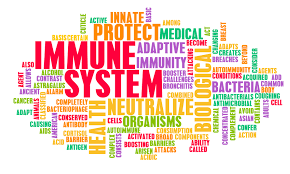The Struggle of Aids in Our Immune System The main drama in the struggle of AIDS takes place in our immune system. From the moment that the body is infected by the first HIV virus, a battle of epic proportion begins in the immune system.

HIV is fighting to kill the immune system, and the immune system is fighting to kill the virus. The battle will continue for the remainder of the patient’s life. In order for you to understand this battle, you will need to know more about the immune system, which is covered in chapter 3.
The Struggle of Aids in Our Immune System
Before the class next week, you should read the chapter to learn about the major components of the immune system. The two major themes that I want to focus on are Innate Immunity and Adaptive Immunity. Each of you should read about both, but you need to select one of these topics to write about for your Preliminary Post.
Option 1: Innate immunity innate is a general name for the non-specific immune responses that provide the body’s first and second lines of defense against invading pathogens. This part of the immune system is not damaged in AIDS, while the adaptive immunity is. It might be helpful to educate AIDS patients on the innate immune system to help them understand what is going on in their bodies, and how to make the most of it.
The Struggle of Aids in Our Immune System
For this discussion, choose one example of innate immunity to focus on. Choose one aspect that was particularly interesting to you. Do some research to find out a little more about it. Here is a list of examples, but you can think of other ones as well:
- describe one type of chemical barrier that the body puts up to keep a pathogen from penetrating the outer wall. Under what conditions is it released? How does it work?
- one part of the inflammatory response such as non-specific phagocytosis. Tell us how that works. You’d probably find it helpful to watch this video:
The Struggle of Aids in Our Immune System
- Tell us how an AIDS patient can work with his/her non-specific pathways to help them work to their optimal capacity, in light of the fact that his adaptive immune system is not working. For example, how can he work with his inflammatory response to get the optimal benefit?
Option 2 – Adaptive Immunity:
In Chapter 3, we also learned about the adaptive immune response. This system used a special class of white blood cells known as lymphocytes to attack specific target antigens that the body has seen in the past. This involves B-cells, T-helper cells and T-killer cells. It is these pathways that are disrupted in AIDS.
For this discussion, choose one example of adaptive immunity to focus on. Choose one aspect that was particularly interesting to you. Do some research to find out a little more about it. Here is a list of examples, but you can think of other ones as well:
Cell-free antibodies are large protein molecules that are released by B-cells as a part of the Humoral Response, which is one arm of the Adaptive Immune Response. There may be millions of B-cells in the body at birth, and each one has been programmed during development to produce a different unique type of antibody molecule that will recognize a single antigen in its lifetime. As such, our bodies have the ability to recognize almost any invading pathogen with at least one type of these antibodies. When our body recognizes a pathogen, it will begin to amplify the B-cell that makes the type of antibody that can recognize it. This will launch a whole body defense, against the pathogen.
The Struggle of Aids in Our Immune System
- Describe the primary immune response, which is what happens the first time that the body recognizes an invading pathogen. Explain what happens to the single B-cell that makes antibodies against that pathogen. How long does after infection does it take for the immune response to knock down the infection?
- Describe the secondary immune response, which is what happens when the same invading pathogen is involved in a re-infection of the body. Since there are now thousands of dormant B-cells that recognize the antigens on the pathogen, how is the immune response enhanced? How quickly does that occur. compared to the first encounter with that pathogen?
- Describe how a vaccine works. Which how does the vaccine replace the primary response? When the pathogen enters the body for the first time in a person who has already been vaccinated, does it encounter a primary immune response or a secondary immune response? Explain.
- There is a second arm of the adaptive immune response known as “Cell-mediated Immunity” which is mediated by using T-cells, rather than B-cells. There two types of T-cell responses, one with the T-Helper cells and one with cytotoxic T-cells. T-Helper cells are the T-cells with the CD4 receptor on the surface, through which the HIV particles enter the cell. It is the T-Helper cells that are killed in AIDS. The second type of T-cell response is with a different type of T-cell, T-killer cells, also known as cytotoxic T cells or CD8+ cells. Here’s the question: If AIDS kills only the T-Helper cells, why are both the humoral (B-cell) and cell-mediated responses (T-cell) pathways knocked out?
The Struggle of Aids in Our Immune System Textbooks
- Required Textbook:
AIDS, Science and Society, Seventh Edition. Jones & Bartlett Learning, Burlington, MA.
Author(s): Hung Y. Fan, Ross F. Conner, Luis P. Villarreal
We can write this or a similar paper for you! Simply fill the order form!




